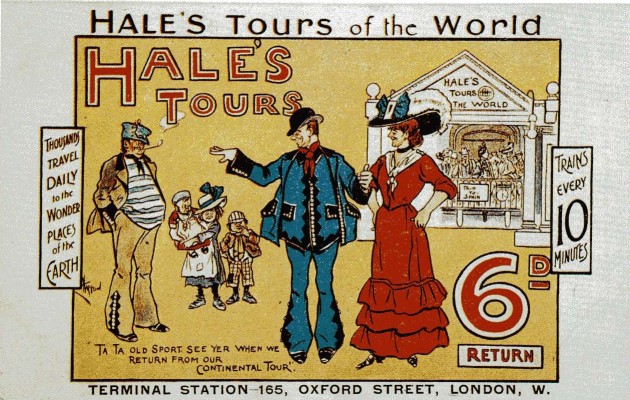Hale’s Tours of the World at 165 Oxford Street, near the corner with Poland Street, was an early train ride simulator and one of the first full-time film venues in London. The attraction was first introduced in America by the entrepreneur George C. Hale at the St Louis Exposition in 1904, and it quickly spread to amusement parks around the country.1 In 1906, the British brass-band promoter Henry Iles travelled to America, and came back with the rights to the new novelty (as well as those for the fairground switchback ride, or rollercoaster).2 The first British branch of Hale’s Tours was opened on Oxford Street later that year, and it would soon be followed by three more in London – at the Olympia exhibition centre, Hammersmith Broadway and Kensington High Street – as well as venues in other cities.3
Situated on a busy shopping street near the Oxford Circus underground station, the earliest British venue was in the perfect location to attract passersby. As with other Hale’s Tours branches, the building was refitted to give the illusion of train travel. After paying the admission fee of 6 pence, customers walking in from Oxford Street would have ascended the short flight of stairs up to a miniature observation platform, with doors leading to a replica train carriage. Inside, a screen at the end of the narrow room formed the carriage’s only window.4 The carriage could accommodate about 50 people at a time on wooden benches, and their ‘journeys’ lasted 15 minutes.5 What viewers saw were ‘phantom ride’ films, shot from the front of moving vehicles, and other travelogues, rear-projected onto the screen from the back of the building. There was no music, but a motor under the floor of the carriage provided movement, and, according to one contemporary account, screenings were accompanied by sound effects:
In the journey through Rome, one could readily believe we were on a tram car; the rumbling of the wheels, the clanging of the bell to clear the traffic, the motion of the vehicle when rounding corners and the other effects were well-timed, free from exaggeration and as natural as one could desire.6
Another observer commented on the performance of the ‘conductor’, ‘who snips the tickets’ on the way in, and ‘lectures pleasantly’ throughout the ‘excursion’.7 After the 15 minutes were up, the viewers departed through exits at the side of the carriage back into the lobby, where the next group of passengers were waiting for their turn.8
The company established in 1906 to handle the Hale’s Tours franchise in Britain went into liquidation at the end of 1908.9 But the Oxford Street branch, which was one of the most profitable, lasted until 1910, when the owners of the buildings at the corner of Oxford Street and Poland Street made plans to redevelop the site. The manager of Hale’s Tours wrote to the local council in June 1910, asking for permission to stay open as long as possible before the demolition work began, but by September the venue had closed.10 However, moving pictures returned to the location in the form of a new 600-seat cinema, the Picture House, which opened in January 1913, and remained open as the Academy until the 1960s.11 The original importer of Hale’s Tours, Henry Iles, went on to become an influential entertainment entrepreneur, developing the Dreamland Amusement Park in Margate.12
Image: Postcard advertising Hale’s Tours of the World, 165 Oxford Street.
Further reading:
- Allen Eyles with Keith Skone, London’s West End Cinemas, third edition (Swindon: English Heritage, 2014).
- Raymond Fielding, ‘Hale’s Tours: Ultrarealism in the Pre-1910 Motion Picture’, in John L. Fell (ed.), Film Before Griffith (Berkeley: University of California Press, 1983), pp. 116-30.
- Christian Hayes, ‘Phantom Carriages: Reconstructing Hale’s Tours and the Virtual Travel Experience’, Early Popular Visual Culture, 7:2 (2009), 185-98.
- Lauren Rabinovitz, ‘Hale’s Tours’, in Richard Abel (ed.), Encyclopedia of Early Cinema (Abingdon: Routledge, 2005), pp. 293-4.
- Dave Russell, ‘Iles, (John) Henry (1871–1951)’, Oxford Dictionary of National Biography (Oxford: Oxford University Press, 2004), online edition: http://www.oxforddnb.com/view/article/48777 (Subscription required).
- Lauren Rabinovitz, ‘Hale’s Tours’, in Richard Abel (ed.), Encyclopedia of Early Cinema (Abingdon: Routledge, 2005), pp. 293-4. ↩
- Dave Russell, ‘Iles, (John) Henry (1871–1951)’, Oxford Dictionary of National Biography (Oxford: Oxford University Press, 2004), online edition: http://www.oxforddnb.com/view/article/48777 ↩
- Raymond Fielding, ‘Hale’s Tours: Ultrarealism in the Pre-1910 Motion Picture’, in John L. Fell (ed.), Film Before Griffith (Berkeley: University of California Press, 1983): p. 125; ‘Creditors’ and Contributors’ Meeting’, The Times, 1 January 1909, p. 3. ↩
- Plan of Hale’s Tours, 21 December 1909, 165 Oxford Street, Building Act Case File (Cinemas), London Metropolitan Archives (LMA), GLC/AR/BR/7/537. ↩
- Report by the London County Council (LCC) on cinematograph displays in unlicensed premises, dated 5 February 1908, National Archives, HO 45/10376, File 161425/6. ↩
- Stroller, ‘Picture Shows As I See Them’, Kinematograph and Lantern Weekly, 1 October 1908, p. 481. ↩
- The Rinking World and Picture Theatre News, 25 December 1909, p. 14: http://picturegoing.com/?p=1712. ↩
- Plan of Hale’s Tours, 21 December 1909, 165 Oxford Street, Building Act Case File. ↩
- ‘Creditors’ and Contributors’ Meeting’. ↩
- Letter from Will C. Pepper to the LCC, 24 June 1910, presented papers of the LCC Theatres and Music Halls Committee, LMA, LCC/MIN/10,939, meeting of 6 July 1910, item 8 (150); Letter from Will C. Pepper, 14 September 1910, 165 Oxford Street, Building Act Case File. ↩
- Allen Eyles with Keith Skone, London’s West End Cinemas, third edition (Swindon: English Heritage, 2014), p. 52. ↩
- Russell, ‘Iles, (John) Henry’. ↩



